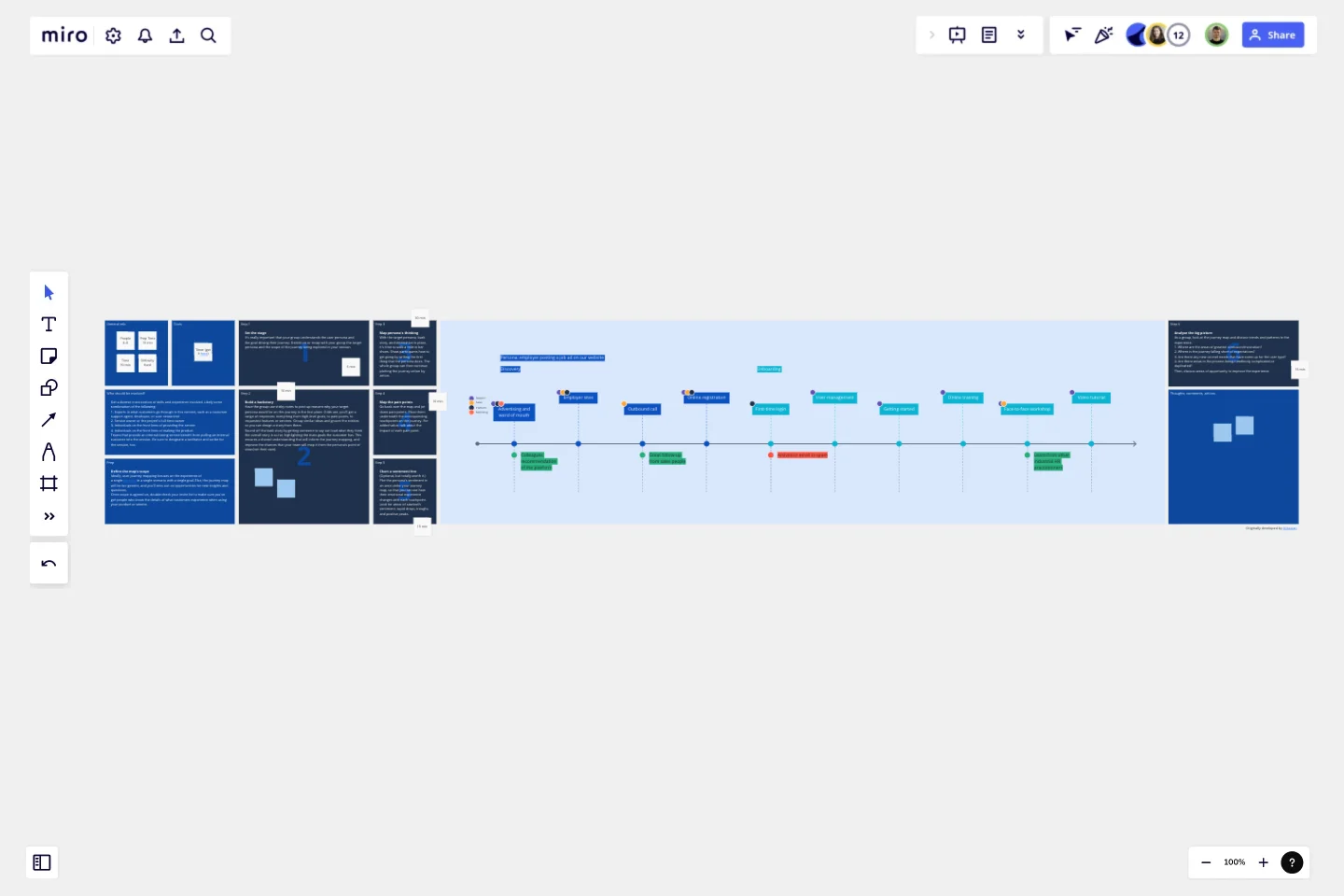Customer Journey Mapping by Atlassian
Guidelines for Customer Journey Mapping.
Step 1: Set the stage
5 minDefine a single persona in a single scenario with a single goal. Decide on or recap with your group the target persona and the scope of the journey being explored in your session.
Step 2: Build a back-story
10 minHave the group use sticky notes to post up reasons why your target persona would be on this journey in the first place. Odds are, you'll get a range of responses: everything from high-level goals, to pain points, to requested features or services. Group similar ideas and groom the stickies so you can design a story from them.
Step 3: Map what the persona thinks and feels
10 minShow participants how to get going by writing the first thing that the persona does on a sticky note. The whole group can then grab stickies and markers and continue plotting the journey action by action, one action per sticky.This can also include questions and decisions! If the journey branches based on the answers or choices, have one participant map out each path.Sometimes user journeys involve more than one channel for interaction, and this could be important for your group to capture. For each action on the journey, ask what channel(s) are involved, and write them as initials on that sticky. Depending on your context, channels might include a website, phone, email, postal mail, face-to-face, and/or social media.It might also help to visually split the mapping area in zones, such as "on-stage" (what the customer experiences) versus "back-stage" (what systems and processes are active in the background).Journey mapping can open up rich discussion, but try to avoid delving into the wrong sort of detail. The idea is to explore the journey and mine it for opportunities to improve the experience instead of coming up with solutions on the spot. Try to be the commentator, not the critic. And remember: you're there to call out what’s going on for the persona, not explain what’s going on with internal systems and processes.
Step 4: Map the pain points
10 minGo back over the map and jot down pain points on sticky notes. Place them underneath the corresponding touchpoints on the journey. Where is there frustration? Errors? Bottlenecks? Things not working as expected?For added value, talk about the impact of each pain point. Is it trivial, or is it likely to necessitate some kind of hack or work-around? Even worse: does it cause the persona to abandon their journey entirely?
Step 5: Chart a sentiment line
15 min(Optional, but totally worth it.) Plot the persona's sentiment in an area under your journey map, so that you can see how their emotional experience changes with each touchpoint. Look for things like:
Areas of sawtooth sentiment — going up and down a lot is pretty common, but that doesn't mean it's not exhausting for the persona.
Rapid drops — this indicates large gaps in expectations, and frustration.
Troughs — these indicate opportunities for lifting overall sentiments.
Positive peaks — can you design an experience that lifts them even higher? Can you delight the persona and inspire them to recommend you?
Remember that pain points don't always cause immediate drops in customer sentiment. Consider whether a pain point early in the journey might result in negative feelings later on.
Step 6: Analyze the big picture
15 minAs a group, stand back from the journey map and discuss trends and patterns in the experience.
Where are the areas of greatest confusion/frustration?
Where is the journey falling short of expectations?
Are there any new unmet needs that have come up for the user type?
Are there areas in the process being needlessly complicated or duplicated? Are there lots of emails being sent that aren’t actually useful?
Then, discuss areas of opportunity to improve the experience. E.g., are there areas in the process where seven steps could be reduced to three? Is that verification email actually needed?
This template was created by Atlassian.
Get started with this template right now.
User Journey Map
Works best for:
Customer Journey Map
A template to help you get started with building simple user journey maps.
User Journey Mapping by Luke Baker
Works best for:
Customer Journey Map
Your guide into journey maps.
Behavior Design Mapping (Journey)
Works best for:
Customer Journey Map
This map is a behavior micro-journey and should be feeding from a higher level map.
Niching Down: Online Course Persona Empathy Map
Works best for:
Market Research, Research & Design
Niching Down Online Course Persona Empathy Map helps you tailor online courses to specific personas. By understanding their needs and motivations, you can design more effective and engaging course content. Perfect for course developers and educators.
Scenario Mapping Template
Works best for:
Desk Research, Mapping, Product Management
Scenario mapping is the process of outlining all the steps a user will take to complete a task. The scenario mapping template helps you create a visual guide to what different personas are doing, thinking, and feeling in different situations. Use scenario mapping to outline an intended or ideal scenario (what should happen) as well as what currently happens. If you’re trying to outline the ideal scenario, user mapping should take place very early on in a project and can help inform user stories and the product backlog. If you’re just trying to get a better sense of what currently happens, you can do user mapping when conducting user interviews or observation.
Practical Customer Journey Mapping by Alex Gilev
Works best for:
Customer Journey Map
Today, customers hold companies to high standards for product quality and user experience.
